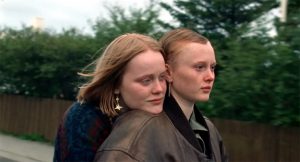Searching for the Light. Sudden loss is difficult to deal with at any time and regardless of what age it affects those left behind. Jan Storø looks at how teenagers react, especially when one of them has to hide a secret concerning the untimely deceased, in Rúnar Rúnarsson’s thoughtful drama.
One of the first things we discover when we watch Rúnar Rúnarsson’s film When the Light Breaks (Ljósbrot) is that it is a sensitive story about young people experiencing an emotionally challenging event. The film is Icelandic, but the story it tells could have easily happened in most other places.
The framework of the narrative is relatively simple. Una (Elín Hall) is about to start a relationship with Diddi (Baldur Einarsson). But before they make it official, Diddi must break up with his current girlfriend, Klara (Katla Njálsdóttir). He travels to Klara to speak to her, but dies in an accident on the road. This leaves Una in a difficult situation; she feels that she can’t reveal her relationship to Diddi to their friends. This becomes especially apparent when Klara also arrives to spend some time with them. Una’s most important friend is Gunni (Micael Kaaber), who understands more than she is aware of.
The reason that this film feels at once both subtle and complex is a result of many factors. Rúnarsson’s script is clearly one of them. There are no traditional conflict lines in this drama of the type we see in many other films. No good guys versus bad guys.
Runarsson does not rush into the main topic of the film. He takes the necessary time to establish the protagonist and her dilemma. We get to know Klara and Gunni as well, but the other friends – and Una’s father – are more distant. Their presence is not needed on the same level as the aforementioned protagonists. Andri Steinn Guðjónsson’s editing supports and strengthens what Rúnarsson had planned. In some parts the editing is slow, in others quicker. It gives us the necessary time and space to be acquainted with the characters and their dilemmas.
All the young people in the film are mourning their lost friend, so young that they have lost a dear one early in their lives, and that makes an interesting challenge for the director. How should one mourn when one does not know how to do it? One of the choices of the young people in the film is to be together. That is actually a good choice. Most adults would make the same choice, but the adults would perhaps seek a quieter togetherness. In the middle part of the film, we are invited to view Rúnarsson´s subtle depiction of the young people’s sorrow. He shows us this in images, and refrains from explaining the facts.
The young actors are also good. Elín Hall as Una is perfect in the role. Her dominantly minimalistic style of acting fits very well into the topic of this film. But also, Njálsdóttir and Kaaber give solid role interpretations of young people trying to navigate in the situation they suddenly find themselves in. All these young people are on their way into the society of adults, but they are not there yet.
As a Nordic person, I enjoyed the fact that two Nordic films from the far north of this part of the world were so central at the 2024 edition of the Cinehill film festival in Croatia. In addition to When the Light Breaks there was also the entry Kalak, by Isabella Eklöf. The latter is a co-production from Denmark, Norway, Sweden, Finland, Greenland and the Netherlands. Most of it takes place in Greenland.
The backdrop of the story is more clearly based in Greenland (and partly in Denmark), whereas When the Light Breaks is connected to a certain Icelandic reality. To understand Kalak fully, one must understand the wish many Greenlanders have to make Greenland independent from Denmark. At the same time Kalak is also a film with more emotional topics, such as love, self-doubt and sexual abuse.
By contrast, When the Light Breaks is not a political film in the same sense that Kalak can be interpreted in such a way. Rúnarsson’s ambition seems to be more emotional. His drama earns our attention in the choice of presenting us to people and their relationships. We meet human beings living their lives in a difficult situation that has just been thrown upon them.
Jan Storø
Edited by Steven Yates
© FIPRESCI 2024

